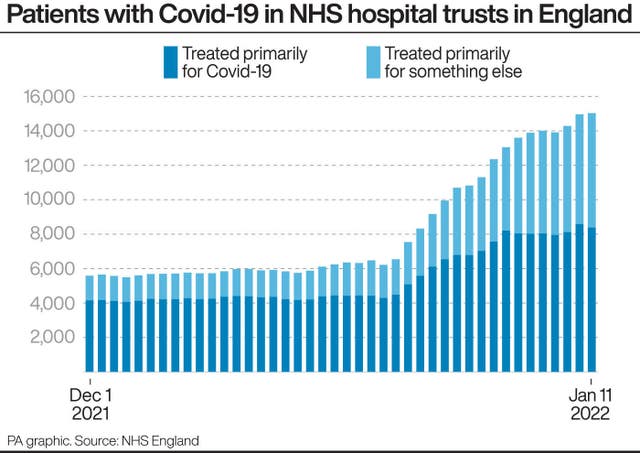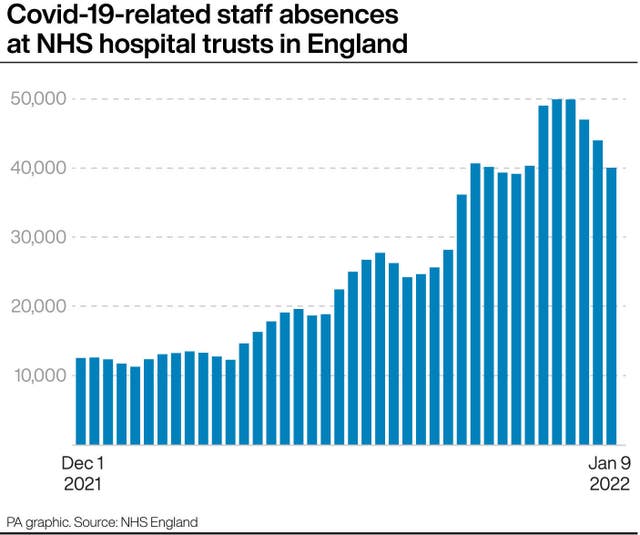Just under half of all patients with coronavirus in the care of NHS hospital trusts in England are being treated primarily for something else, new figures show.
Of the 15,026 patients reported as having the virus on January 11, 6,647 (44%) were not being treated principally for Covid-19, according to NHS England.
This is the highest proportion since these figures were first published in June 2021, and is up from 26% at the start of December.

All hospital patients who have tested positive for Covid-19 need to be treated separately from those who do not have the virus, regardless of whether they are in hospital primarily for Covid or not.
But the growing proportion of patients who are in hospital “with” Covid rather than “for” Covid is another sign that the current wave of the virus is not causing the same sort of pressure on hospitals as previous waves.
The latest data came as Health Secretary Sajid Javid said “there are already early signs that the rate of hospitalisation is starting to slow”.
He told the Commons on Thursday that Omicron “still has the potential to lead to significant numbers of people in hospital. There’s already almost 17,000 Covid-19 patients in hospital in England.
“Due to the lag between infections and hospitalisations, the NHS will remain under significant pressure over the next few weeks.
“It is encouraging, however, that during this wave we have not seen an increase in Covid-19 intensive care patients, and there are already early signs that the rate of hospitalisation is starting to slow.
“We know that Omicron is less severe. But no-one should be under any illusions – it is severe for anyone that ends up in hospital, and that’s far more likely if you have not had the jab.”

The number of people in hospital in the UK with Covid-19 has fallen for the second day in a row, with 19,721 patients recorded on January 12, the latest Government figures show.
This is still higher than the number a week earlier, but is down from 19,864 on January 10.
During the second wave of coronavirus last winter, the number of patients peaked at 39,254 on January 18 2021.
There were 2,184 Covid-19 hospital admissions on January 9, the latest date for which figures are available, below the recent peak of 2,599 on December 29.
Separate figures, also published on Thursday, showed that 80 of the 135 acute trusts in England which submitted data had bed occupancy levels above 90% every day in the week to January 9 above the recommended limit of 85%.
Both Warwickshire’s George Eliot Hospital Trust and the Wrightington, Wigan and Leigh Foundation Trust in Greater Manchester had general and acute bed occupancy levels of 100%.

The figures show that the George Eliot’s general and acute beds were full from January 6 to 9, while Wrightington, Wigan and Leigh had 100% bed occupancy on six days since the start of the month.
This is coupled with high levels of staff being absent due to Covid, with the latest figures showing a 2% rise week on week between January 2 and 9.
But while overall 40,031 NHS staff at hospital trusts in England were absent for Covid-19 reasons on January 9, the daily data suggests that, after reaching a peak of 49,941 on January 5, the numbers have dropped every day since then.
The new data shows regional differences, though most of the regions of England are seeing a drop in absent staff.
The figures suggest one in 25 (4%) of NHS staff working in acute hospital trusts are off sick or self-isolating due to Covid, based on NHS Digital monthly workforce data for September for acute trusts – the most recent available.
Chesterfield Royal Hospital Foundation Trust had the highest proportion of staff off due to Covid on January 9 based on its September headcount, at 11%.
The Royal Orthopaedic Hospital Foundation Trust in Birmingham; Wrightington, Wigan and Leigh Foundation Trust; North Tees and Hartlepool Foundation Trust; University Hospitals of Leicester Foundation Trust; Northern Care Alliance Foundation Trust; and Royal United Hospitals Bath Foundation Trust were all at 8%.
Nuffield Trust deputy director of research Sarah Scobie said: “The latest data shows substantial and damaging levels of staff absences.
“On average, over 88,500 staff were absent every day across NHS hospitals in the week ending January 9, an increase of 10% from the previous week.
“Absences of this scale are impacting the availability of staff and beds, as well as the safe and effective running of services.”




Comments: Our rules
We want our comments to be a lively and valuable part of our community - a place where readers can debate and engage with the most important local issues. The ability to comment on our stories is a privilege, not a right, however, and that privilege may be withdrawn if it is abused or misused.
Please report any comments that break our rules.
Read the rules here